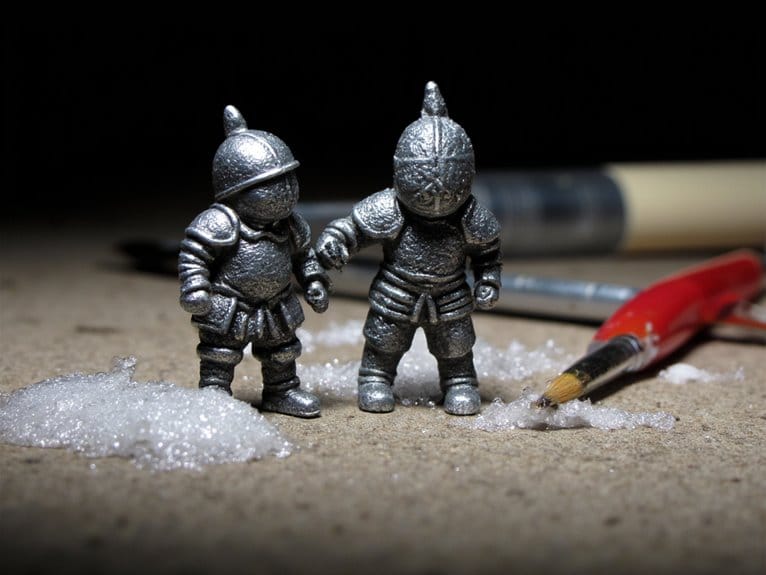We are supported by our audience. When you purchase through links on our site, we may earn an affiliate commission, at no extra cost for you. Learn more. Last update on 1st July 2025 / Images from Amazon Product Advertising API.
You can prevent airbrush paint from drying out by maintaining proper paint consistency at a milk-like texture using a 50/50 paint-to-thinner ratio, controlling your workspace temperature between 60°F-80°F with 40-60% humidity, and using correct trigger techniques that stop paint flow before airflow. Fine needles and detailed work accelerate drying due to increased air exposure, so flush your airbrush every 10-15 minutes during extended sessions. These foundational strategies will considerably extend your painting time before encountering tip buildup issues.
Notable Insights
- Maintain workspace temperature between 60°F-80°F and humidity between 40%-60% to prevent rapid paint evaporation.
- Thin paint to milk-like consistency using proper paint-to-thinner ratios to improve flow and reduce tip drying.
- Stop paint flow before stopping airflow by pushing trigger forward first, then releasing completely.
- Flush airbrush immediately after use and wipe needle tip with damp cloth between applications.
- Use drying retarders in low humidity environments and avoid direct airflow on painting surfaces.
Understanding Why Paint Dries on Airbrush Needles
When you’re airbrushing fine details or making subtle color shifts, you’ve likely encountered the frustrating phenomenon of paint drying on your needle tip. This occurs primarily during small trigger movements that generate high air volume with minimal paint flow. The slow paint movement allows rapid drying and buildup formation.
Paint viscosity plays a critical role in this process. Thicker acrylics, especially whites, dry faster due to higher solvent concentration. Needle exposure to environmental factors like airflow and temperature accelerates evaporation.
Fine-diameter needles have greater surface area relative to paint volume, speeding the drying process. The thin paint film on needle surfaces evaporates quickly under airflow conditions. Using ready-to-spray formulas can help minimize this issue since they’re specifically designed with optimal flow consistency that reduces drying time problems. This creates the foundation for clogs and performance issues that’ll plague your painting session. Almost every airbrush clog is preceded by paint drying on the needle tip. To prevent this buildup, you should fully pull the trigger every few strokes to rush wet paint over the needle tip and clear any dried residue.
Preparing Paint to the Right Consistency
Achieving the right paint consistency forms the foundation for preventing tip dry and maintaining smooth airbrush operation. Your target consistency should resemble milk—fluid enough for proper atomization yet thick enough to maintain color opacity.
Perfect paint consistency—like milk—prevents tip dry while ensuring smooth airbrush operation and optimal color opacity.
Start with a 50/50 paint-to-thinner ratio as your baseline, then adjust based on spray test results.
Effective mixing techniques require these key steps:
- Mix paint and thinner in small containers for precise ratio control
- Stir gently to avoid introducing air bubbles that cause spattering
- Test consistency on similar surfaces before final application
- Adjust gradually with additional medium or thinner as needed
Your consistency adjustments should match your nozzle size and air pressure settings. Thinner paint requires lower pressure, while thicker formulations need higher pressure for proper atomization. Higher air pressures between 18 to 22 PSI improve atomization quality and help prevent paint buildup that leads to tip drying.
Consider using airbrushes with interchangeable nozzles ranging from 0.2mm to 0.5mm to better accommodate different paint viscosities and detail requirements.
For optimal results, use brand-specific reducers that are formulated to work with your particular paint system to ensure consistency and reliability across different environmental conditions.
Controlling Your Workspace Environment
Your workspace environment directly impacts how quickly airbrush paint dries on the needle tip and in your paint cup.
Temperature fluctuations, improper humidity levels, and poor airflow control can cause premature paint drying that leads to clogs and inconsistent spray patterns.
You’ll need to establish specific environmental controls for temperature, humidity, and workspace protection to maintain ideal paint flow throughout your airbrushing sessions. Using Airbrush Medium for proper thinning helps maintain consistent viscosity and prevents rapid drying even in challenging environmental conditions.
Professional-grade paints with high-purity pigments offer better consistency and flow characteristics that resist environmental factors compared to lower quality alternatives.
Regular monitoring of your needle tip during painting sessions helps catch paint buildup before it affects your spray quality.
Temperature and Humidity Control
While many airbrush enthusiasts focus solely on paint consistency and technique, environmental conditions play an equally essential role in preventing paint from drying out prematurely.
You’ll need to maintain your workspace temperature between 60°F and 80°F (16°C to 26°C) for ideal paint performance. Temperature adjustments outside this range create significant problems—below 60°F causes paint thickening and prolonged drying, while excessive heat above 100°F leads to surface skinning and bubbling. Lower temperatures increase paint thickness, which can clog airbrush nozzles and disrupt spray patterns.
Humidity effects are equally critical to monitor:
- Keep relative humidity between 40% and 60% for balanced solvent evaporation
- Use dehumidifiers in high-moisture environments to prevent tip drying issues
- Install hygrometers for continuous humidity monitoring
- Avoid direct airflow from heating/cooling devices onto paint surfaces
Stable environmental controls guarantee predictable drying times and consistent atomization.
Workspace Setup Protection
Beyond temperature and humidity control, protecting your workspace from contamination and establishing efficient workflow patterns prevents paint drying issues before they start. Your workspace layout directly impacts paint preservation.
Position your paint mixing station away from direct airflow to minimize solvent evaporation. Wipe surfaces regularly to maintain dust-free conditions that prevent particulate contamination on wet paint surfaces.
Install protective barriers using painter’s tape or removable sheets on work surfaces for easy cleanup. These barriers prevent paint residue buildup that can flake into fresh work.
Use drop cloths or butcher paper around your airbrushing area to catch overspray and protect surrounding surfaces. Organize all tools, cleaning materials, and paint supplies within arm’s reach before starting.
This preparation eliminates workflow interruptions that cause paint to dry in your airbrush during extended sessions.
Essential Airbrush Maintenance Practices
Your airbrush’s performance depends entirely on how well you maintain its internal components and prevent paint from hardening inside the system.
Regular cleaning routines form the foundation of proper airbrush care, requiring a thorough flush every 10–15 uses and immediate cleaning after each painting session to remove wet paint before it dries.
Proper component care involves systematic maintenance of needles, nozzles, and paint reservoirs to guarantee consistent spray patterns and prevent costly damage from dried paint buildup.
Using a quality cleaning pot with effective filtration systems ensures mess-free cleanup and helps contain overspray during your maintenance routine.
Regular Cleaning Routines
Because airbrush maintenance directly determines paint flow consistency and equipment longevity, establishing daily cleaning routines prevents the costly problems that plague neglected equipment.
Your cleaning schedule should include immediate flushing after each paint use and between color changes to prevent cross-contamination. Select cleaning agents based on paint type—water works for acrylics while enamels require specific solvents.
Implement these essential daily practices:
- Flush airbrush immediately after paint application
- Empty all paint reservoirs completely after sessions
- Wipe nozzle and tip with damp cloth between uses
- Keep water or cleaner within reach for spot cleaning
Schedule deep cleaning every 10-15 uses. Disassemble components and soak removable parts in appropriate cleaners. Address sputtering or uneven spray immediately to prevent permanent damage.
Proper Component Care
Daily cleaning routines won’t prevent paint drying issues if you’re neglecting the specific components that control paint flow through your airbrush system.
Your needle requires precise adjustment to match paint viscosity. Replace worn needles showing irregular taper or damage immediately. These compromised components create inconsistent spray patterns that promote faster paint drying and clogging.
| Component | Replacement Frequency | Signs of Wear |
|---|---|---|
| Needles | Every 3-6 months | Bent tips, scoring |
| Nozzles | Every 6-12 months | Irregular spray patterns |
| Seals | Annual | Cracking, hardening |
| Springs | 12-24 months | Loss of tension |
| Triggers | 18-36 months | Sticking, poor response |
Select needle tapers matching your specific paint viscosity requirements. Single-taper needles work best for thin paints, while dual-taper designs handle thicker formulations effectively. Monitor air pressure settings regularly—improper pressure accelerates tip dry formation during detailed work sessions.
Proper Spraying Techniques to Prevent Drying
While many airbrush problems stem from equipment issues or paint consistency, mastering proper spraying techniques forms the foundation for preventing paint from drying during application.
Your trigger control directly affects paint flow and tip drying. Always begin by pressing the trigger fully down for airflow before pulling back to release paint.
Essential spraying techniques include:
- Stop paint flow before stopping airflow by pushing trigger forward, then releasing
- Maintain smooth, consistent trigger movements throughout application
- Avoid releasing air while paint’s still flowing to prevent tip buildup
- Practice proper sequence to extend spraying sessions up to 15 minutes
This consistent approach prevents the erratic paint flow that causes premature drying.
Smooth trigger operation maintains steady atomization while preventing the stop-start patterns that create tip dry conditions during detailed work.
On a final note
You’ve now got the essential techniques to prevent paint drying issues. Monitor your workspace humidity at 40-60% and temperature between 68-72°F. Thin paints to milk-like consistency using manufacturer-recommended ratios. Clean your needle every 15-20 minutes during extended sessions. Use proper air pressure settings between 15-30 PSI depending on your paint type. Apply these maintenance practices consistently, and you’ll eliminate most drying problems before they start.

